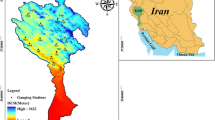Abstract
To establish the drought index objectively and reasonably and evaluate the hydrological drought accurately, firstly, the optimal distribution was selected from nine distributions (normal, lognormal, exponential, gamma, general extreme value, inverse Gaussian, logistic, log-logistic and Weibull), then the Optimal Standardized Streamflow Index (OSSI) was calculated based on the optimal distribution, and last, the spatiotemporal evolution of hydrological drought based on the OSSI series was investigated through the monthly streamflow data of seven hydrological stations during the period 1961–2011 in Luanhe River basin, China. Results suggest: (1) the general extreme value and log-logistic distributions performed prominently in fitting the monthly streamflow of Luanhe River basin. (2) The main periods of hydrological drought in Luanhe River basin were 148–169, 75–80, 42–45, 14–19 and 8–9 months. (3) The hydrological drought had an aggravating trend over the past 51 year and with the increase in timescale, the aggravating trend was more serious. (4) The lower the drought grade was, the broader the coverage area. As for the Luanhe River basin, the whole basin suffered the mild and more serious drought, while the severe and more serious drought only cover some areas. (5) With the increase in time step, the frequency distribution of mild droughts across the basin tended to be concentrated, the frequency of extreme droughts in middle and upper reaches tended to increase and the frequency in downstream tends to decrease. This research can provide powerful references for water resources planning and management and drought mitigation.










Similar content being viewed by others
References
Awange JL, Khandu SM et al (2016) Exploring hydro-meteorological drought patterns over the Greater Horn of Africa (1979–2014) using remote sensing and reanalysis products. Adv Water Resour 94:45–59
Hamed KH, Rao AR (1998) A modified Mann–Kendall trend test for autocorrelated data. J Hydrol 204(1):182–196
Hayes M, Wilhite DA, Svoboda M et al (1999) Monitoring the 1996 drought using the standardized precipitation index. Bull Am Meteor Soc 80:429–438
Hong X, Guo S, Zhou Y et al (2014) Uncertainties in assessing hydrological drought using Streamflow Drought Index for the upper Yangtze River basin. Stoch Environ Res Risk Assess 29(4):1235–1247
Huang NE, Shen Z, Long SR et al (1998) The empirical mode decomposition method and the Hilbert spectrum for non-stationary time series analysis. Philos Trans R Soc 454:903–995
Kang S, Lin H (2007) Wavelet analysis of hydrological and water quality signals in an agricultural watershed. J Hydrol 338(1–2):1–14
Kendall M (1975) Rank correlation methods. Charles Griffin, London
Lin Q et al (2017) Correlation between hydrological drought, climatic factors, reservoir operation, and vegetation cover in the Xijiang Basin, South China. J Hydrol 549:512–524
Liu Z, Xia X, Zhou W (2015) A test for equality of two distributions via jackknife empirical likelihood and characteristic functions. Comput Stat Data Anal 92:97–114
Lu WX, Chen SM, Luo JN (2013) Meteorological drought characteristics research of western Jilin Province based on wavelet analyses. Appl Mech Mater 295–298:2121–2126
Mann HB (1945) Nonparametric tests against trend. Econometrica 13(3):245–259
McMahon TA, Pegram GGS, Vogel RM et al (2007) Revisiting reservoir storage–yield relationships using a global streamflow database. Adv Water Resour 30(8):1858–1872
Nalbantis I, Tsakiris G (2008) Assessment of hydrological drought revisited. Water Resour Manag 23(5):881–897
Panagiotis A, Fotios M, Nikos K et al (2012) Computation of drought index SPI with alternative distribution functions. Water Resour Manag 26:2453–2473
Peel MC, Wang QJ, Vogel RM et al (2001) The utility of L-moment ratio diagrams for selecting a regional probability distribution. Hydrol Sci J 46(1):147–155
Sang YF, Wang Z, Liu C (2014) Comparison of the MK test and EMD method for trend identification in hydrological time series. J Hydrol 510:293–298
Shukla S, Wood AW (2008) Use of a standardized runoff index for characterizing hydrologic drought. Geophys Res Lett 35(2):226–236
Spinoni J, Naumann G, Vogt JV et al (2015) The biggest drought events in Europe from 1950 to 2012. J Hydrol 3:509–524
Tabari H, Nikbakht J, Hosseinzadeh Talaee P (2012) Hydrological drought assessment in northwestern iran based on Streamflow Drought Index (SDI). Water Resour Manag 27(1):137–151
Thomas J, Prasannakumar V (2016) Temporal analysis of rainfall (1871–2012) and drought characteristics over a tropical monsoon-dominated State (Kerala) of India. J Hydrol 534:266–280
Trinh T, Ishida K, Kavvas ML et al (2017) Assessment of 21st century drought conditions at Shasta Dam based on dynamically projected water supply conditions by a regional climate model coupled with a physically-based hydrology model. Sci Total Environ 586:197–205
Vicente-Serrano SM, Beguería S, López-Moreno JI (2010) A multiscalar drought index sensitive to global warming: the standardized precipitation evapotranspiration index. J Clim 23(7):1696–1718
Wu Z, Lin Q, Lu G et al (2015) Analysis of hydrological drought frequency for the Xijiang River Basin in South China using observed streamflow data. Nat Hazards 77(3):1655–1677
Yue S, Wang CY (2002) Power of the Mann–Whitney test for detecting a shift in median or mean of hydro-meteorological data. Stoch Environ Res Risk Assess 16(4):307–323
Acknowledgments
The authors sincerely acknowledge the insightful comments and corrections of editors and reviewers. This investigation is supported by the Natural Science Foundation of China (Nos. 51579169, 51279123, 51179117) and the National Key Research and Development Plan (Grant No. 2016YFC0401407).
Author information
Authors and Affiliations
Corresponding author
Appendix
Appendix
See Fig. 11.
Rights and permissions
About this article
Cite this article
Chen, X., Li, Fw. & Feng, P. Spatiotemporal variation of hydrological drought based on the Optimal Standardized Streamflow Index in Luanhe River basin, China. Nat Hazards 91, 155–178 (2018). https://doi.org/10.1007/s11069-017-3118-6
Received:
Accepted:
Published:
Issue Date:
DOI: https://doi.org/10.1007/s11069-017-3118-6






